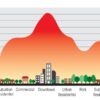Google Land Cover Dynamic World offers a fascinating glimpse into how our planet’s landscapes are changing. This data, encompassing diverse land types globally, provides a unique historical perspective, revealing shifts and patterns over time. Understanding these dynamics is crucial for various fields, from environmental monitoring to urban planning and beyond.
This comprehensive analysis explores the factors driving these transformations, from natural processes to human activity. It delves into the methods used to track these changes, examining the tools and techniques employed in land cover analysis. The discussion also highlights the applications of this data in various fields, illustrating its impact on our understanding of the environment, urban development, agriculture, and resource management.
Ultimately, the goal is to equip readers with a clearer picture of our dynamic planet and the critical role of land cover in shaping it.
Introduction to Google Land Cover Data

Google’s Earth Engine platform provides a wealth of land cover data, offering a comprehensive view of the planet’s surface. This data is crucial for understanding global environmental changes, tracking deforestation, and supporting sustainable development initiatives. The datasets are regularly updated, providing a dynamic picture of the ever-evolving landscapes.This data allows researchers, policymakers, and environmentalists to monitor and analyze changes in land use patterns over time.
The information is readily accessible and can be used for various applications, from identifying areas at risk of desertification to predicting crop yields. The global scope of the data provides a unique opportunity to assess the impacts of human activities on the environment across different regions and ecosystems.
Types of Land Cover Data
Understanding the different types of land cover data available is essential for choosing the appropriate dataset for specific applications. Google Earth Engine offers a range of products, each designed to capture specific aspects of the Earth’s surface. These include various spectral bands, often reflecting different properties of the land cover.
- Land Cover Classification Maps: These maps categorize land surfaces into predefined classes, such as forests, grasslands, urban areas, and water bodies. These classifications are based on spectral characteristics, derived from satellite imagery, enabling researchers to identify areas of specific land cover types and track changes over time. An example of this could be identifying the expansion of urban areas in a specific region over a decade.
- Time-Series Data: This data provides a historical record of land cover changes, enabling the identification of trends and patterns. For instance, tracking deforestation in the Amazon rainforest over the past 20 years helps understand the impact of human activities on this critical ecosystem. This is invaluable for studying long-term ecological changes.
- High-Resolution Imagery: High-resolution satellite imagery offers detailed views of specific locations. This level of detail is vital for applications such as urban planning, agriculture, and conservation efforts. For example, analyzing high-resolution imagery can help determine the extent of crop damage after a natural disaster or pinpoint areas needing conservation efforts in a national park.
Global Scope of the Data
The global scope of Google’s land cover data is a significant advantage. It allows researchers and policymakers to study land cover changes across the entire planet. This enables comparisons between different regions and identification of global trends.
- Comparative Analysis: Analyzing data across various continents facilitates a comparative understanding of land use patterns. This comparative study reveals patterns that may not be visible in localized studies.
- Global Environmental Monitoring: The comprehensive coverage enables global environmental monitoring, allowing for a broader understanding of the effects of human activities on ecosystems. The data helps assess the impact of climate change and human-induced environmental stress.
- International Cooperation: The global nature of the data promotes international cooperation in addressing global environmental challenges. Shared data enables better collaboration in identifying and addressing issues like deforestation and desertification.
Historical Context of Land Cover Data Collection
The collection of land cover data has a rich history, evolving from early manual methods to advanced satellite imagery techniques. The historical context provides insights into the advancements and limitations of previous methods.
- Early Methods: Early methods for land cover data collection often relied on manual mapping and ground surveys, which were time-consuming and limited in scope. This approach provided valuable historical context but had significant limitations in terms of accuracy and coverage.
- Technological Advancements: The advent of satellite technology revolutionized land cover data collection. Satellite imagery provided unprecedented global coverage and enabled the creation of large-scale land cover maps with greater accuracy.
- Continuous Improvement: The field of land cover data collection is constantly evolving. New technologies and methodologies continue to enhance data accuracy, resolution, and accessibility, enabling researchers to track land use changes in greater detail and with improved accuracy.
Significance for Various Fields
The implications of this data are widespread, influencing numerous fields, including environmental science, urban planning, and agriculture. The significance of this data stems from its ability to track changes and provide context for critical decision-making.
- Environmental Science: Land cover data is essential for monitoring and understanding ecological changes, identifying biodiversity hotspots, and tracking the impact of environmental factors on ecosystems.
- Urban Planning: The data helps in assessing urban expansion, managing urban resources, and developing sustainable urban development strategies.
- Agriculture: Land cover data provides valuable information for crop monitoring, yield prediction, and agricultural planning. This includes identifying areas suitable for specific crops and monitoring crop health.
Dynamic Nature of Land Cover
Land cover, the physical characteristics of the Earth’s surface, is constantly in flux. From bustling urban sprawl to shrinking forests, these changes are driven by a complex interplay of natural and human-induced factors. Understanding these dynamics is crucial for effective resource management and predicting future environmental scenarios.The factors driving land cover change are multifaceted and often intertwined. Natural processes like volcanic eruptions, wildfires, and seasonal variations significantly impact the landscape.
Human activities, including deforestation for agriculture, urbanization, and infrastructure development, are also powerful drivers of land cover transformations. Climate change further complicates the picture, influencing patterns of drought, flooding, and vegetation growth.
Factors Influencing Land Cover Change
A variety of factors influence the ever-shifting nature of land cover. These include natural events like droughts and floods, as well as human activities like agriculture, urbanization, and industrial development. Understanding the relative importance of each factor in different regions is key to predicting future land cover transformations.
Examples of Global Land Cover Shifts
The Amazon rainforest, a vital carbon sink, has experienced significant deforestation over recent decades, largely due to agricultural expansion. This deforestation, a visible example of land cover change, contributes to greenhouse gas emissions and biodiversity loss. Conversely, urban areas worldwide have expanded rapidly, consuming agricultural lands and natural habitats. These examples illustrate the profound impact human activities have on the Earth’s surface.
Temporal Resolution of Google Land Cover Datasets
Google’s land cover datasets provide a valuable resource for studying these changes over time. The temporal resolution of these datasets indicates the frequency at which land cover is mapped. For instance, if a dataset has a yearly resolution, it maps land cover once per year. The higher the resolution, the more detailed the temporal analysis. Higher temporal resolutions allow for a more granular understanding of short-term land cover changes, which can be crucial for monitoring events like deforestation.
Methods for Monitoring Land Cover Changes
Various methods are employed to track these transformations. Remote sensing, utilizing satellite imagery, is a primary tool. Different types of satellite sensors, with varying spectral capabilities, capture data at different wavelengths. These data are then processed and analyzed to identify changes in land cover characteristics. Geographic Information Systems (GIS) software plays a critical role in managing and analyzing the vast amounts of spatial data.
Tools and Technologies in Land Cover Analysis
Sophisticated tools and technologies support these analyses. Remote sensing platforms, like Landsat and Sentinel satellites, capture imagery of the Earth’s surface, providing a comprehensive record of land cover. This imagery is analyzed using advanced image processing algorithms. These techniques are essential for identifying and quantifying changes in land cover over time. Geographic Information Systems (GIS) are instrumental in mapping, analyzing, and visualizing land cover data.
Google’s land cover dynamic world maps are fascinating, showing how landscapes shift over time. But while Google is doing impressive work visualizing the Earth’s changing surface, it seems they’ve missed the mark with their recent RCS messaging global rollout; it’s a bit like trying to fix a leaky roof after the house has flooded, which is a bit of a missed opportunity.
This whole situation highlights the need for more careful planning, especially when dealing with global adoption of new technologies. Google’s land cover dynamic world project, however, continues to be an incredible resource for understanding our planet’s evolution. google finally made rcs messaging world wide thing its too late fix anything.
GIS allows for the integration of various data types, including satellite imagery, elevation data, and socioeconomic information. Furthermore, machine learning algorithms are increasingly used to automate the identification and classification of land cover types.
Applications of Dynamic Land Cover Data
Dynamic land cover data, constantly evolving with changing environmental conditions, offers a powerful tool for understanding and managing our planet. This data, meticulously tracked over time, reveals intricate patterns of environmental change, enabling us to anticipate future trends and make informed decisions across various sectors. From monitoring ecosystems to shaping urban development, land cover data serves as a critical component in addressing complex global challenges.
Environmental Monitoring
Land cover data is invaluable for tracking changes in ecosystems. It allows researchers and conservationists to monitor deforestation, urbanization, desertification, and other environmental transformations. By comparing land cover maps from different time periods, scientists can quantify the rate and extent of these changes, enabling the identification of vulnerable areas and the development of targeted conservation strategies. For instance, a study in the Amazon rainforest might show a significant increase in deforestation rates between 2010 and 2020, triggering further investigation into the causes and potential mitigation measures.
Urban Planning and Development
This data is critical for urban planning and development. Land cover information helps identify suitable areas for infrastructure projects, while also allowing planners to anticipate potential environmental impacts. This information can also aid in managing urban sprawl and protecting natural resources within city limits. By analyzing historical land cover data, urban planners can predict future population growth and resource needs, thereby enabling the development of sustainable urban designs.
Google’s dynamic land cover maps are fascinating, showing how the world’s landscapes shift over time. But similar to how nature adapts, your IT infrastructure needs to be robust and connected, not self-isolating. If your systems aren’t collaborating effectively, they’re missing out on crucial insights, just like a disconnected part of Google’s land cover project might miss a critical shift in the data.
This interconnectedness is key to accurately understanding the ever-changing world around us, and the importance of a cohesive IT system cannot be understated. For a deeper dive into why your IT infrastructure shouldn’t be self-isolating, check out this helpful article: why your it infrastructure should not self isolate. Ultimately, a healthy, integrated IT infrastructure is just as important as a comprehensive view of Google’s land cover data.
This predictive capability allows for optimized infrastructure placement, reducing environmental stress and maximizing resource utilization.
Agriculture and Resource Management
Land cover data plays a crucial role in agriculture and resource management. It aids in identifying suitable agricultural lands, assessing the health of forests, and optimizing water resource allocation. For example, monitoring changes in agricultural land use can help farmers understand the impact of climate change on crop yields, leading to the adoption of climate-resilient agricultural practices. Furthermore, by tracking forest cover, resource managers can identify areas needing conservation efforts, thus ensuring the sustainable use of forest resources.
Climate Change Studies
Land cover data is fundamental to climate change studies. It allows researchers to assess the impact of land use change on greenhouse gas emissions and carbon sequestration. By analyzing the evolution of forests, wetlands, and other ecosystems over time, scientists can gain insights into the complex interplay between land cover and climate. For example, deforestation can release significant amounts of carbon dioxide into the atmosphere, exacerbating climate change.
Understanding these linkages is crucial for developing effective strategies to mitigate climate change.
Disaster Response
Dynamic land cover data is a valuable tool in disaster response. By mapping areas of high vulnerability, disaster management agencies can prioritize aid distribution and evacuation efforts. For example, land cover data can reveal areas prone to flooding, landslides, or wildfires, enabling proactive measures to reduce the impact of these disasters. Post-disaster, land cover data can be used to assess damage, track recovery efforts, and identify areas needing reconstruction.
This data enables efficient resource allocation and swift disaster recovery.
Data Visualization and Analysis Techniques

Unveiling the intricate patterns within land cover data requires robust visualization and analysis techniques. Effectively representing this data allows researchers and policymakers to understand land use changes, identify trends, and make informed decisions. This section delves into various methods for visualizing land cover data and analyzing changes, crucial for monitoring environmental shifts and guiding sustainable development strategies.
Land Cover Visualization Methods
Different visualization methods provide varying perspectives on land cover data. Choosing the appropriate method depends on the specific research question and the nature of the data.
| Method | Strengths | Weaknesses | Use Cases |
|---|---|---|---|
| Choropleth Maps | Simple to create and understand; effectively displays spatial distribution of land cover types. | Can obscure local variations within a region; may not capture nuanced patterns. | General land cover distribution; broad regional comparisons; identifying areas with high concentrations of specific land cover types. |
| Satellite Imagery | High-resolution detail; direct visual representation of land cover features; captures temporal changes. | Requires specialized software for analysis; potentially high data volume; interpretation can be subjective. | Detailed assessments of specific sites; detecting land cover changes over time; studying vegetation dynamics; urban sprawl monitoring. |
| 3D Models | Provides a realistic, immersive perspective of land cover; allows for analysis from multiple angles. | Requires extensive processing of data; potentially complex to create; can be computationally expensive. | Complex landscape assessments; visualizing terrain features; analyzing urban development; demonstrating impact of natural disasters. |
Land Cover Change Detection Techniques
Analyzing changes in land cover over time is critical for understanding environmental processes and human impacts. Different techniques provide various levels of detail and accuracy in detecting these changes.
| Technique | Methodology | Suitability |
|---|---|---|
| Change Vector Analysis (CVA) | Identifies the magnitude and direction of land cover changes between two or more images. | Effective for detecting both gains and losses of specific land cover types; good for quantifying changes. |
| Image Differencing | Subtracting pixel values from successive images to highlight differences. | Simple and efficient for identifying areas of change; less accurate for complex changes. |
| Spectral Mixture Analysis | Separates the spectral signatures of different land cover types in a single image. | Useful for characterizing mixed pixels; good for mapping subtle changes in vegetation cover. |
Tools and Software for Land Cover Analysis
A variety of tools and software facilitate the analysis of land cover data.
- QGIS: An open-source geographic information system (GIS) that provides a wide range of tools for manipulating and analyzing spatial data, including land cover data. It’s particularly useful for creating maps and performing spatial analyses.
- Google Earth Engine: A cloud-based platform for analyzing geospatial datasets, including satellite imagery. It provides tools for processing, visualizing, and analyzing large datasets of land cover data.
- ENVI (Environmental Information System): A commercial software package that offers advanced capabilities for analyzing remotely sensed data, including land cover classification and change detection.
Creating Interactive Maps from Land Cover Data
Interactive maps offer a dynamic and engaging way to explore and visualize land cover data. Creating interactive maps allows for user-driven exploration and interpretation of the data. Tools like Leaflet, JavaScript libraries, and dedicated GIS software can be used to build interactive maps.
Statistical Methods in Land Cover Analysis
Statistical methods are essential for quantifying and interpreting land cover data. These methods help identify patterns, trends, and relationships within the data. For example, statistical models can be used to predict future land cover changes or to assess the impact of environmental factors on land cover dynamics.
Google’s land cover dynamic world maps are fascinating, showing how landscapes shift over time. But what about personal data? If you’re looking to delete your 23andMe genetic data account, 23andme genetic data account deletion how to is a good resource. Ultimately, understanding how our personal information is tracked and managed alongside these global shifts in land cover is important.
It’s a complex web, but hopefully, tools like Google’s maps can continue to help us visualize and understand these changes.
Global Land Cover Change Patterns: Google Land Cover Dynamic World
The Earth’s land surface is constantly evolving, with changes driven by natural processes and human activities. Understanding these patterns is crucial for predicting future landscapes, managing resources effectively, and mitigating environmental impacts. This dynamic nature of land cover is intricately linked to biodiversity, ecosystem services, and human well-being.The intricate dance between natural forces and human actions profoundly shapes global land cover.
From the relentless march of urbanization to the subtle shifts in forest cover, these changes are not uniform across the globe. Understanding these variations is essential for targeted interventions and sustainable development strategies.
Major Trends in Global Land Cover Change
Significant global trends in land cover change are evident. Forests are shrinking due to deforestation for agriculture and urbanization. Urban areas continue to expand, consuming previously natural landscapes. Wetlands are being drained for development or agriculture, impacting water resources and biodiversity. Agricultural land conversion plays a major role in these changes, often leading to habitat loss and fragmentation.
Land Cover Changes in Different Regions
The impacts of these global trends manifest differently in various regions. Tropical forests, for example, are experiencing rapid deforestation due to logging and agricultural expansion. This loss contributes significantly to carbon emissions and biodiversity loss. In contrast, urban areas show continuous expansion, altering landscapes and often leading to increased pollution and habitat loss. These changes vary significantly based on economic development levels and policies implemented.
Successful Land Cover Restoration Projects
Several successful land cover restoration projects illustrate the potential for reversing negative trends. Reforestation initiatives, particularly in degraded areas, have shown promise in restoring ecosystem functions and biodiversity. Community-based approaches, incorporating local knowledge and sustainable practices, often yield the best outcomes. For instance, initiatives in the Amazon region, focusing on sustainable agriculture and community engagement, have demonstrated positive outcomes in protecting forests.
Potential Impacts on Biodiversity
Changes in land cover significantly impact biodiversity. Deforestation and habitat fragmentation reduce suitable habitats for many species, leading to population declines and potential extinctions. The loss of wetlands and other crucial ecosystems directly affects biodiversity and reduces the provision of ecosystem services. These changes are not isolated events; they are interconnected and have cascading effects throughout the environment.
Role of Human Activities in Shaping Patterns
Human activities are a primary driver of land cover change. Agriculture, logging, urbanization, and infrastructure development all contribute to these transformations. The intensity and scale of these activities vary across regions, reflecting differences in economic development, population density, and policy frameworks. Sustainable land use practices, such as promoting agroforestry and responsible resource management, can mitigate these negative impacts.
Examples of Successful Land Cover Restoration
Reforestation efforts in the Appalachian Mountains have successfully restored degraded forest landscapes, creating new habitats for wildlife and enhancing carbon sequestration. These efforts often involve local communities, emphasizing long-term sustainability and ecosystem resilience. Similarly, initiatives to restore wetlands in the Everglades have helped revitalize water resources and enhance biodiversity.
Future Trends and Challenges
The future of land cover analysis is poised for significant advancements, driven by technological innovations and the increasing urgency of environmental monitoring. This evolving field offers exciting opportunities for understanding and addressing global challenges like deforestation, urbanization, and climate change. However, challenges remain in ensuring the accuracy, accessibility, and ethical use of this vital data.
Future Advancements in Data Collection and Analysis, Google land cover dynamic world
Technological advancements are revolutionizing land cover data acquisition and analysis. Remote sensing, particularly high-resolution satellite imagery and airborne LiDAR, will provide increasingly detailed and frequent updates. Machine learning algorithms, such as deep learning models, will play a crucial role in automating the process of classifying and interpreting land cover from vast datasets. This automation will enhance efficiency and potentially reduce the cost of analysis.
Potential Challenges in Using Land Cover Data
Several challenges are associated with leveraging land cover data. Ensuring data quality and consistency across different sources and time periods is critical. Addressing the computational demands of processing and analyzing massive datasets is another significant hurdle. Data access and sharing limitations can hinder the use of land cover data, particularly in developing countries. The cost of acquiring and processing the data also presents a barrier for some users.
Ethical Considerations Surrounding Land Cover Data
The use of land cover data raises several ethical concerns. The potential for misuse of data for discriminatory purposes or land-grabbing activities must be carefully addressed. Data privacy and security are paramount. Ensuring transparency and accountability in data collection and analysis processes is essential to building public trust. Clear guidelines and regulations should be developed to prevent unauthorized access and manipulation of the data.
Innovative Applications of Land Cover Data for the Future
Land cover data holds immense potential for innovative applications. The data can be utilized to model the impact of climate change on ecosystems, inform urban planning strategies, and support conservation efforts. Developing predictive models of land cover change can help anticipate future environmental trends. Land cover data can be crucial for disaster risk assessment and management. For instance, understanding the land cover surrounding a vulnerable area can aid in the development of early warning systems for natural disasters.
Methods for Improving Accuracy and Reliability of Land Cover Data
Improving the accuracy and reliability of land cover data is a continuous process. Multi-sensor data fusion techniques can combine data from different sources to enhance classification accuracy. Ground-truthing, or the process of validating satellite imagery with on-the-ground observations, remains a vital component. Continuous calibration and validation procedures are crucial to maintain the accuracy and reliability of the data over time.
Regular updates to the classification systems and algorithms used in analysis will also improve data reliability. The development of more robust and flexible algorithms can help reduce errors and enhance the accuracy of the land cover data.
Concluding Remarks
In conclusion, Google Land Cover Dynamic World reveals a dynamic planet, constantly reshaped by a complex interplay of natural and human forces. The insights gained from analyzing this data are invaluable for various fields, from environmental protection to urban planning. From the intricacies of land cover change detection to the global patterns emerging from these transformations, this exploration underscores the importance of understanding our planet’s evolving landscapes.
Further advancements in data collection and analysis techniques will undoubtedly lead to even more profound insights in the future.






